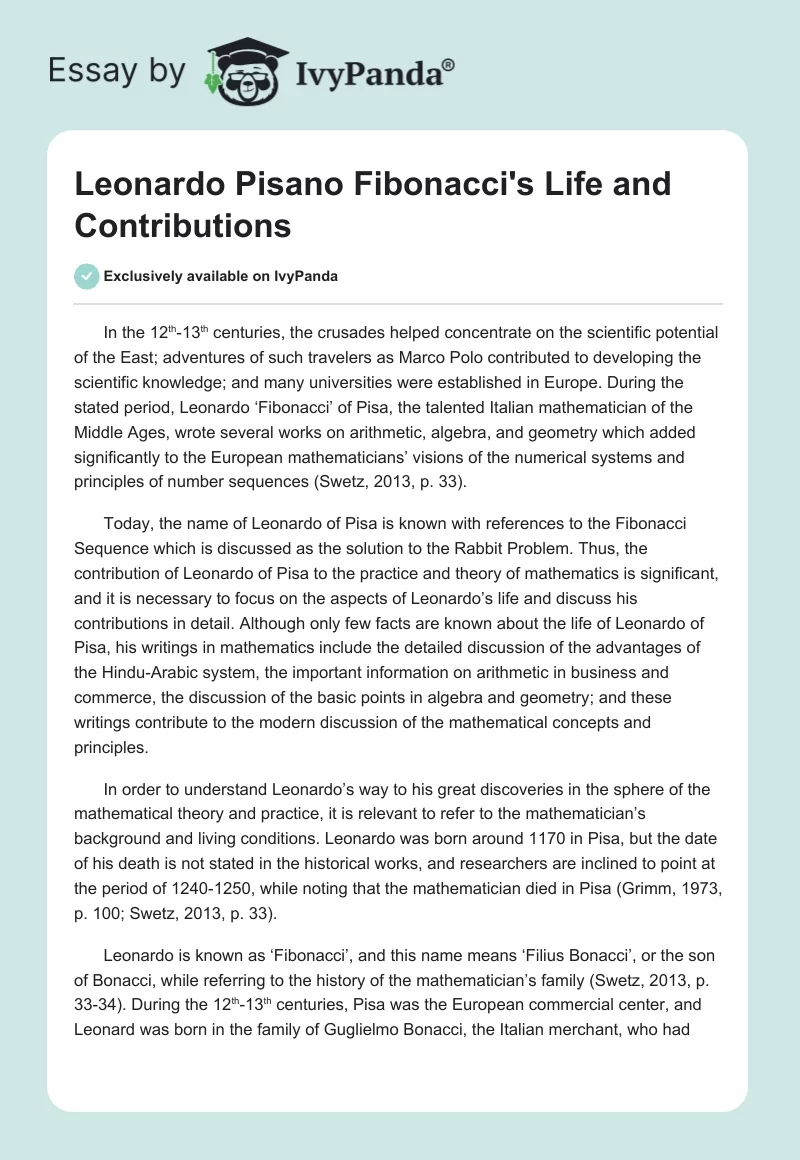In the 12th-13th centuries, the crusades helped concentrate on the scientific potential of the East; adventures of such travelers as Marco Polo contributed to developing the scientific knowledge; and many universities were established in Europe. During the stated period, Leonardo ‘Fibonacci’ of Pisa, the talented Italian mathematician of the Middle Ages, wrote several works on arithmetic, algebra, and geometry which added significantly to the European mathematicians’ visions of the numerical systems and principles of number sequences (Swetz, 2013, p. 33).
Today, the name of Leonardo of Pisa is known with references to the Fibonacci Sequence which is discussed as the solution to the Rabbit Problem. Thus, the contribution of Leonardo of Pisa to the practice and theory of mathematics is significant, and it is necessary to focus on the aspects of Leonardo’s life and discuss his contributions in detail. Although only few facts are known about the life of Leonardo of Pisa, his writings in mathematics include the detailed discussion of the advantages of the Hindu-Arabic system, the important information on arithmetic in business and commerce, the discussion of the basic points in algebra and geometry; and these writings contribute to the modern discussion of the mathematical concepts and principles.
In order to understand Leonardo’s way to his great discoveries in the sphere of the mathematical theory and practice, it is relevant to refer to the mathematician’s background and living conditions. Leonardo was born around 1170 in Pisa, but the date of his death is not stated in the historical works, and researchers are inclined to point at the period of 1240-1250, while noting that the mathematician died in Pisa (Grimm, 1973, p. 100; Swetz, 2013, p. 33).
Leonardo is known as ‘Fibonacci’, and this name means ‘Filius Bonacci’, or the son of Bonacci, while referring to the history of the mathematician’s family (Swetz, 2013, p. 33-34). During the 12th-13th centuries, Pisa was the European commercial center, and Leonard was born in the family of Guglielmo Bonacci, the Italian merchant, who had warehouses in Bugia of Africa (Koshy, 2011, p. 1-2). To develop the son’s interest in commerce, Bonacci focused on the boy’s perfect mathematical education.
Young Leonardo lived in Bugia during a long period of time while being taught by the Muslim teacher. Leonardo understood the basics of arithmetic rather quickly, and he started travelling in the Mediterranean region. While visiting Egypt, Greece, Sicily, Syria, and Constantinople, Leonardo studied the arithmetic systems used in these countries, met scholars to develop his knowledge, and evaluated different money systems, while applying the principles of arithmetic to commerce.
Finally, Leonardo focused on the advantages of the Hindu-Arabic system and placed it even higher than the traditional method of Pythagoras used in Italy (Swetz, 2013, p. 33-34). These ideas and evaluations were reflected in Leonardo’s several writings on mathematical questions.
While focusing on Leonardo’s interests and contributions, it is important to discuss the mathematician’s works. Leonardo wrote Liber Abaci (I) in 1202. Today, this writing is discussed as the most important one because the mathematician reflected his ideas on arithmetic and algebra influenced by the Arabic mathematical thought. Leonardo’s complete work reflects his interests not only in mathematics but also in commerce (Grimm, 1973, p. 100-103; Swetz, 2013, p. 34). Thus, Leonardo proposed the detailed discussion of numbers, integers, and fractions, and then focused on the discussion of commerce notions such as prices, barter, and partnership.
In 1228, there was the second edition of Liber Abaci. This work is also important and interesting because Leonardo provides the solution to the Rabbit Problem in these writings. This solution is known today as the Fibonacci Sequence which consists of such numbers as 1, 2, 3, 5, 8, 13… (Swetz, 2013, p. 34). This sequence is actively used today to state different types of relationship and regularity. The other famous writings such as Practica Geometriae (1220) and Liber Quadratorum (1225) also provide many theorems and rules which are important for the modern practical geometry (Koshy, 2011, p. 2-3; Swetz, 2013, p. 34). The reputation of Leonardo as the talented mathematician was supported with his participation in large mathematical tournaments which demonstrated the significance of Leonardo’s mathematical thought.
Thus, Leonardo’s contributions to mathematics are numerous. One of these contributions is the focus on accentuating the advantages of the Hindu-Arabic numerical and mathematical system which is actively used in Europe today. The next contribution which is relevant even nowadays is the development of the unique sequence to state the relationship known as the Fibonacci Sequence. The sequence is based on the detailed discussion of the theoretical and practical points of arithmetic and algebra. Furthermore, Leonardo ‘Fibonacci’ of Pisa proposed the discussion of the aspects of commerce which are discussed today as the basics of business.
From this point, in spite of the fact that Leonardo of Pisa declared his ideas in the early 13th century, his statements are relevant and actively used in mathematics and commerce even today. The role of Leonardo’s contributions to the field of mathematics depends on the depth and completeness of the mathematician’s discussions which are supported with logical arguments as the basics of Leonardo’s conclusions.
References
Grimm, R. E. (1973). The autobiography of Leonardo Pisano. Fibonacci Quarterly, 11(1), 99–104. Web.
Koshy, T. (2011). Fibonacci and Lucas Numbers with Applications. New York, NY: John Wiley & Sons. Web.
Swetz, F. (2013). The European mathematical awakening: A journey through the history of mathematics from 1000 to 1800. New York, NY: Courier Dover Publications. Web.


